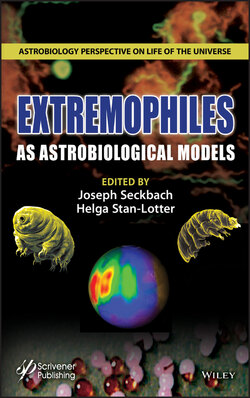Читать книгу EXTREMOPHILES as Astrobiological Models - Группа авторов - Страница 37
2.4 Biodiversity in the Tinto Basin
ОглавлениеCombining conventional and molecular microbial ecology methods allowed the most characteristic organisms associated with the Tinto basin to be identified [2.72] [2.57] [2.6] [2.49] [2.94] [2.96] [2.3]. Remarkably, over eighty per cent of the water column diversity corresponds to microorganisms belonging to only three bacterial genera: Leptospirillum spp. (strict aerobic iron oxidizers), Acidiphilium spp. (iron reducers), and Acidithiobacillus ferrooxidans (an aerobic iron oxidizer and an anaerobic iron reducer), all of them well-known members of the iron cycle [2.57].
Although other bacterial and archaeal iron-oxidizers (members of Ferrimicrobium, “Ferrovum,” Ferrimicrobium and Thermoplasma genera) or bacterial iron-reducers (members of Ferrimicrobium, Metallibacterium and Acidobacterium genera) have been identified in the Tinto ecosystem [2.57] [2.47] [2.49]. Their low numbers, as detected by fluorescence in situ hybridization, suggest that they have a less important role in the water column.
Regarding the sulfur cycle, only At. ferrooxidans was detected in significant numbers in the water column. Sulfate-reducing microorganisms were also detected in the sediments at different locations along the river [2.75] [2.49] [2.94] [2.95] [2.96] [2.44] [2.45], thus a subsidiary sulfur cycle is also operative along the course of the river.
It is assumed that the toxicity of high concentrations of heavy metals existing in extreme acidic environments impairs the development of eukaryotic microorganisms in these ecosystems [2.59]. Nevertheless, multicolored algal biofilms can be easily observed covering important areas along the river (Figure 2.1). A careful estimation of this phenomenon allowed López-Archilla and collaborators to conclude that more than sixty per cent of the primary production in the river is due to photosynthetic eukaryotic organisms [2.72]. Members of the Chlamydomonas, Chlorella and Euglena genera, all belonging to the Chlorophyta phylum, are the dominant eukaryotic microorganisms detected in the Tinto basin [2.5] [2.6] [2.2] [2.3]. Also, filamentous algae of the Klebsormidium and Zygnemopsis genera were identified in the river. Species of the Dunaliella and Cyanidium genera can be found colonizing the most extreme area in the origin of the river. Members of these genera are well known for their tolerance to toxic heavy metals [2.1] [2.3]. Large brown biofilms made of pennate diatoms of the genus Pinnularia can be detected along the course of the Tinto basin [2.2] [2.3] [2.4].
Unicellular and filamentous fungi are the most diverse eukaryotes detected in the Tinto basin [2.72] [2.73]. A recent characterization of Rio Tinto fungal diversity from samples obtained along the river has rendered three hundred and fifty isolates, which is a small representation of the fungal diversity existing in the Tinto basin. Internal transcribed spacer (ITS) sequence analysis showed that Ascomycetes is the most abundant phylum, followed by Basidiomycetes and Zygomycetes. Among the Ascomycetes, more than fifty per cent cluster within the Eurotiomycetes class, followed by Dothideomycetes, Sordariomycetes, Helotiales and Mucorales. A systematic survey of fungal metal tolerance showed that members of the Sordariomycetes and the Eurotiomycetes classes are the most resistant to high concentration of toxic heavy metals, in some cases several orders of magnitude higher than the concentration measured in the water column. Interestingly enough, many different fungal isolates from the Tinto basin can grow in the presence of high concentrations of individual toxic metals, such as As, Ni, Co, Cr, Cu, but their tolerance decreases severely in the presence of combinations of these toxic heavy metals. In addition, some metals with low toxicological profile, such as Fe and Al, can increase the fungal tolerance of individual or combined toxic metals.
Heterotrophic protists are also found along the river. The mixotrophic community is dominated by cercomonads and stramenopiles belonging to the Ochromonas, Bodo and Cercomonas genera. The protistan consumer community is characterized by two different ciliates identified as members of the Euplotes and Oxytricha genera. Amoebas related to the Vahlkampfia and Naegleria genera are found in the most acidic part of the river. Members of the heliozoan belonging to the Actinophyros genus are the most characteristic predators of the benthic food chain [2.5] [2.2] [2.3]. The bdelloid rotifer of the genus Rotifera is the only member of the animal phylum detected so far in Rio Tinto [2.5].
Due to the interest of aerobic chemolithotrophs in biohydrometallurgical processes, the characterization of the anoxic sediments from acidic environments had been neglected in the past, with few exceptions [2.74]. A comparative analysis of the microbial diversity associated with sediments and the correspondent water column showed a significantly higher level of diversity in the sediments [2.49]. Most of the microorganisms identified in this study were somehow related to the iron cycle. Most of them have been isolated or identified in biomining operations or AMD sites [2.60] [2.61] [2.57] [2.58] [2.92] [2.47]. Nonetheless, some bacteria, such as members of Firmicutes, Acidobacteria, Actinobacteria, Planctomycetes and Chloroflexi phyla, were identified for the first time in the Tinto basin [2.49].
A thorough analysis of two closely located anoxic sediments from the origin of the river has recently shown major phylogenetic differences. In one of the sediments, members of the Firmicutes followed by Acidobacteria phyla corresponded to the most numerous group of Bacteria. In the other sediment, members of the Proteobacteria followed by members of the Actinobacteria phyla were the most represented [2.94]. Members of Firmicutes and Acidobacteria were also present but at rather low numbers. Sulfate-reducing bacteria have always been identified in the strict anoxic conditions existing in the lower part of the sediments, indicating that this energy conservation system is a frequent metabolic activity in the anaerobic part of the ecosystem, probably due to the high concentration of sulfates detected [2.75] [2.94] [2.11].
